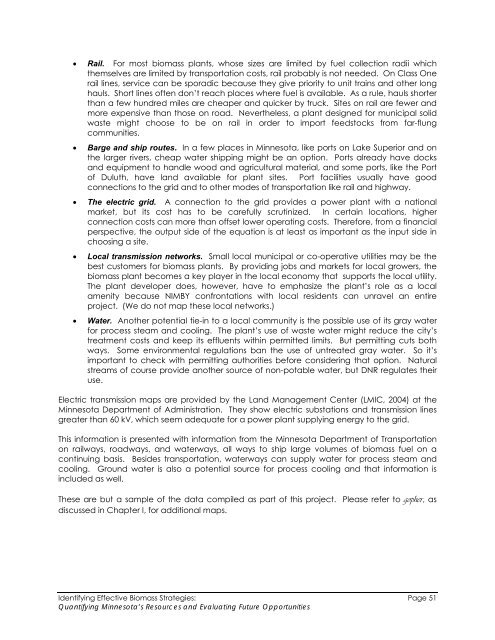Biomass Feasibility Project Final Report - Xcel Energy
Biomass Feasibility Project Final Report - Xcel Energy
Biomass Feasibility Project Final Report - Xcel Energy
You also want an ePaper? Increase the reach of your titles
YUMPU automatically turns print PDFs into web optimized ePapers that Google loves.
• Rail. For most biomass plants, whose sizes are limited by fuel collection radii which<br />
themselves are limited by transportation costs, rail probably is not needed. On Class One<br />
rail lines, service can be sporadic because they give priority to unit trains and other long<br />
hauls. Short lines often don’t reach places where fuel is available. As a rule, hauls shorter<br />
than a few hundred miles are cheaper and quicker by truck. Sites on rail are fewer and<br />
more expensive than those on road. Nevertheless, a plant designed for municipal solid<br />
waste might choose to be on rail in order to import feedstocks from far-flung<br />
communities.<br />
• Barge and ship routes. In a few places in Minnesota, like ports on Lake Superior and on<br />
the larger rivers, cheap water shipping might be an option. Ports already have docks<br />
and equipment to handle wood and agricultural material, and some ports, like the Port<br />
of Duluth, have land available for plant sites. Port facilities usually have good<br />
connections to the grid and to other modes of transportation like rail and highway.<br />
• The electric grid. A connection to the grid provides a power plant with a national<br />
market, but its cost has to be carefully scrutinized. In certain locations, higher<br />
connection costs can more than offset lower operating costs. Therefore, from a financial<br />
perspective, the output side of the equation is at least as important as the input side in<br />
choosing a site.<br />
• Local transmission networks. Small local municipal or co-operative utilities may be the<br />
best customers for biomass plants. By providing jobs and markets for local growers, the<br />
biomass plant becomes a key player in the local economy that supports the local utility.<br />
The plant developer does, however, have to emphasize the plant’s role as a local<br />
amenity because NIMBY confrontations with local residents can unravel an entire<br />
project. (We do not map these local networks.)<br />
• Water. Another potential tie-in to a local community is the possible use of its gray water<br />
for process steam and cooling. The plant’s use of waste water might reduce the city’s<br />
treatment costs and keep its effluents within permitted limits. But permitting cuts both<br />
ways. Some environmental regulations ban the use of untreated gray water. So it’s<br />
important to check with permitting authorities before considering that option. Natural<br />
streams of course provide another source of non-potable water, but DNR regulates their<br />
use.<br />
Electric transmission maps are provided by the Land Management Center (LMIC, 2004) at the<br />
Minnesota Department of Administration. They show electric substations and transmission lines<br />
greater than 60 kV, which seem adequate for a power plant supplying energy to the grid.<br />
This information is presented with information from the Minnesota Department of Transportation<br />
on railways, roadways, and waterways, all ways to ship large volumes of biomass fuel on a<br />
continuing basis. Besides transportation, waterways can supply water for process steam and<br />
cooling. Ground water is also a potential source for process cooling and that information is<br />
included as well.<br />
These are but a sample of the data compiled as part of this project. Please refer to gopher, as<br />
discussed in Chapter I, for additional maps.<br />
Identifying Effective <strong>Biomass</strong> Strategies: Page 51<br />
Quantifying Minnesota’s Resources and Evaluating Future Opportunities

















